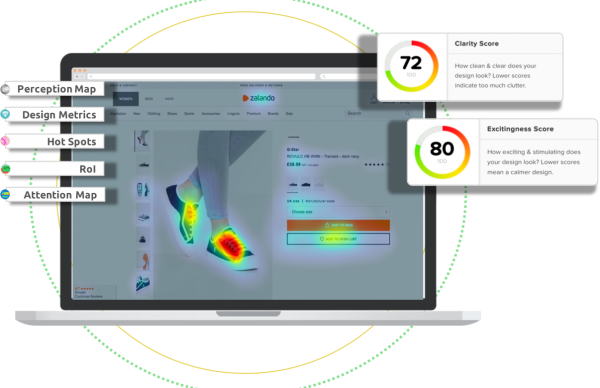We value your privacy
This website uses cookies to ensure you get the best experience on our website.
 Skip to main content
Skip to main content
This website uses cookies to ensure you get the best experience on our website.
World-leading Design Institution, Loughborough University, has partnered with EyeQuant to offer all MSC UX Design students the ability to bring science into their design processes through AI-simulated eye-tracking technology.
LONDON, UK., Feb. 25, 2021 – For the first time, EyeQuant, an AI that predicts how users will engage with website designs, has been chosen by Loughborough University – School of Design and Creative Arts – to test the effectiveness of the student’s designs in a safe environment.
Since the COVID-19 Pandemic hit, Universities have faced an incredibly tough challenge as to how they can provide an excellent student experience while complying to changing regulations and, primarily, keeping students safe.
UX lecturer, Dr Christopher J. Parker, commented “previously, we’d used cutting-edge eye-tracking hardware to illustrate the importance of capturing human attention. But now, due to COVID restrictions preventing our staff and students from meeting in labs, we’ve had to look for safer, faster and more cost-effective solutions. EyeQuant fills this gap. With EyeQuant, our students can instantly analyse their designs to explore and justify their design decisions like they had a personal UX lab at their disposal. So far, the students have been pleasantly surprised to learn which elements of their prototypes create fixation and focal points.”
He continued “universities and higher education institutions have really felt the impact of the pandemic. Because of that, we’ve turned to innovative technologies, like EyeQuant, to ensure that students still receive the best experience possible.”
EyeQuant CEO, Charlie Blake-Thomas, added “we are delighted to be working with such a prestigious design institution like Loughborough University. We work with some of the smartest minds in deep learning and neuroscientific research, so it’s amazing to see EyeQuant being taught amongst the next cohort of leading UX Designers. Our mission is to enable every designer to have access to our AI so that they can craft digital experiences that surpass consumers expectations.”
–ENDS–
About Loughborough University:
Loughborough is one of the country’s leading universities. It has an international reputation for research that matters, excellence in teaching, strong links with industry, and unrivalled achievement in sport and its underpinning academic disciplines.
In every UK league table, Loughborough University is in the top 10; 7th in The Guardian University League Table 2021, 6th in the UK Complete University Guide 2021, and 5th in the Times Higher Education Table of Tables 2020. QS Stars university rating scheme awarded Loughborough five stars in 2020, while naming it the world’s best university for sports-related subjects. In recognition of its contribution to the sector, Loughborough has been awarded seven Queen’s Anniversary Prizes.
Loughborough School of Design and Creative Arts matches the university’s excellent reputation. In 2020, the QS Rankings placed Loughborough at 24th in the world for Art and Design, six places above the University of Oxford.
About EyeQuant:
For the first time in history, UX, marketing, and product teams can now use data to design, iterate and improve every piece of creative, eliminating subjective opinion for optimum conversion.
Developed by leading neuro and data scientists, EyeQuant removes the need for expensive and timely eye-tracking studies by simulating a 200-person study in seconds.
The likes of Google, AKQA, Lego and Oracle are among a growing number of brands reaping the rewards of our patented technology.
Media Enquiries:
Alice Henebury
alice@eyequant.com



Check out our latest top tips on how you can use EyeQuant to spy on your competitors, analyse mobile...
Read more
In our latest blog we explore how to use neuroscience to help create higher performing digital products.
Read more
Figma is the go-to prototyping platform for many UX and web designers – and not without reason. Its functionality,...
Read more